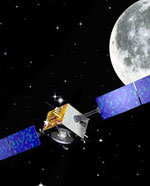
Image credit: ESA
The European Space Agency’s Smart-1 spacecraft has been mated to the top of its Ariane 5 rocket, and everything is ready to go for its September 27th launch. Smart-1’s primary mission will be to test out new technologies, including solar electric (ion) propulsion and autonomous navigation. Even though it’s launching in just a few days, it will arrive at the Moon in January 2005, where it will begin analyzing the chemical composition of the Moon’s surface. It will also search for evidence of water ice at the Moon’s southern pole.
Europe’s first mission to the Moon will soon be under way, and UK scientists are looking forward to unravelling some of the secrets of our neighbouring world.
SMART-1 – the European Space Agency’s first Small Mission for Advanced Research in Technology -is now expected to lift off from Kourou, French Guiana, just after midnight on Sunday, 28 September.
Although it is primarily intended to demonstrate innovative technologies such as solar-electric (ion) propulsion and autonomous navigation, SMART-1 also carries a number of scientific experiments that will provide new insights into some of the unanswered questions about our nearest celestial neighbour.
On arrival in lunar orbit (expected to be in January 2005), these instruments will search for signs of water ice in permanently shaded craters near the Moon’s poles, provide data on the still uncertain origin of the Moon, and reconstruct its evolution by mapping the surface distribution of minerals and key chemical elements.
The main UK contribution is a compact X-ray spectrometer known as D-CIXS (pronounced dee-kicks), which has been developed by Principal Investigator, Professor Manuel Grande, and his team at CCLRC Rutherford Appleton Laboratory. D-CIXS will help to determine the elements that make up the lunar surface and so provide important information about how the Moon was formed.
“Despite decades of research, we have never fully discovered what the Moon is made of,” said Professor Grande. “The Apollo missions only explored the equatorial regions on the Earth-facing side of the Moon, while other spacecraft only investigated surface colour or searched for water and heavy elements. D-CIXS will provide the first global X-ray map of the elements that make up the Moon.
“X-rays from the Sun cause atoms in the lunar surface to fluoresce – rather like the gas in the fluorescent tubes that light our offices and homes – so that they emit X-rays of their own. D-CIXS will measure the Moon’s composition by detecting these X-rays coming from the lunar surface. The precise energy carried by each X-ray tells us the element that is emitting it.
“This information will provide us with vital clues to help us understand the origins of our Moon.”
In order to create an instrument that is the size of a toaster and weighs just 4.5 kilograms, the D-CIXS team had to miniaturise the components and develop new technology such as novel X-ray detectors – based on new swept charge devices (similar to the charged couple devices found in digital cameras) and microfabricated collimators with walls no thicker than a human hair.
Other UK institutions involved in D-CIXS are:- University of Sheffield, Queen Mary University of London, Natural History Museum, Armagh Observatory, University College London, Mullard Space Science Laboratory and the University of Manchester.
Dr. Sarah Dunkin of CCLRC-RAL and University College London is also a Co-Investigator on the SMART-1 Infrared Spectrometer (SIR), which will search for ice and produce a global map of lunar minerals.
The main UK industrial involvement is by SEA Group Ltd, who helped to develop the Ka-band Telemetry and Telecommand Experiment (KaTE) which will test more efficient communication techniques for deep space missions.
Original Source: RAS News Release
